Damaged Crops – What to Do When Hail and Wind Damage Your Garden
This post may contain affiliate links. Read my full disclosure here.
This week we were hit by a hail storm while my son and I were running errands. As we were pulling away from our home, I looked over at the garden and noticed how big and healthy the squash patch was looking, and how glad I was that we were expecting much needed rain.
While we were driving around, the rain started pouring in buckets, but I wasn’t concerned. Then the hail started, but it was spotty, so I still wasn’t concerned. It was only when I turned onto the last stretch of road to our home that my heart dropped.

The road was filled with fallen leaves. As I pulled up to our home, I saw the squash patch – leveled to the ground with hail damage. The rest of the garden had plenty of weather damage, too – damaged fruit, damaged flowers, shredded and stripped leaves – it was pretty awful.
Damaged crops are a given. How bad it will be remains to be seen. I can’t unmake the storm, but I can share our strategies for dealing with the weather damage in the garden, and options to help prevent hail damage.
Damaged Leaves
The first thing I noticed was the leaves. Broad leaf plants like the squash, melons and cucumbers were hardest hit. The corn damage was pretty severe, too. The corn leaves look like shredded ribbons.
What to do for leaf damage:
Fight Disease
Damaged leaves are more susceptible to disease, so we loaded up the backpack sprayer with Effective Microorganisms (EM-1). EM-1 acts like a plant probiotic, seeding plant surfaces with helpful bacteria. A good quality compost tea would also work.
Purchase EM-1 Microbial Inoculant here
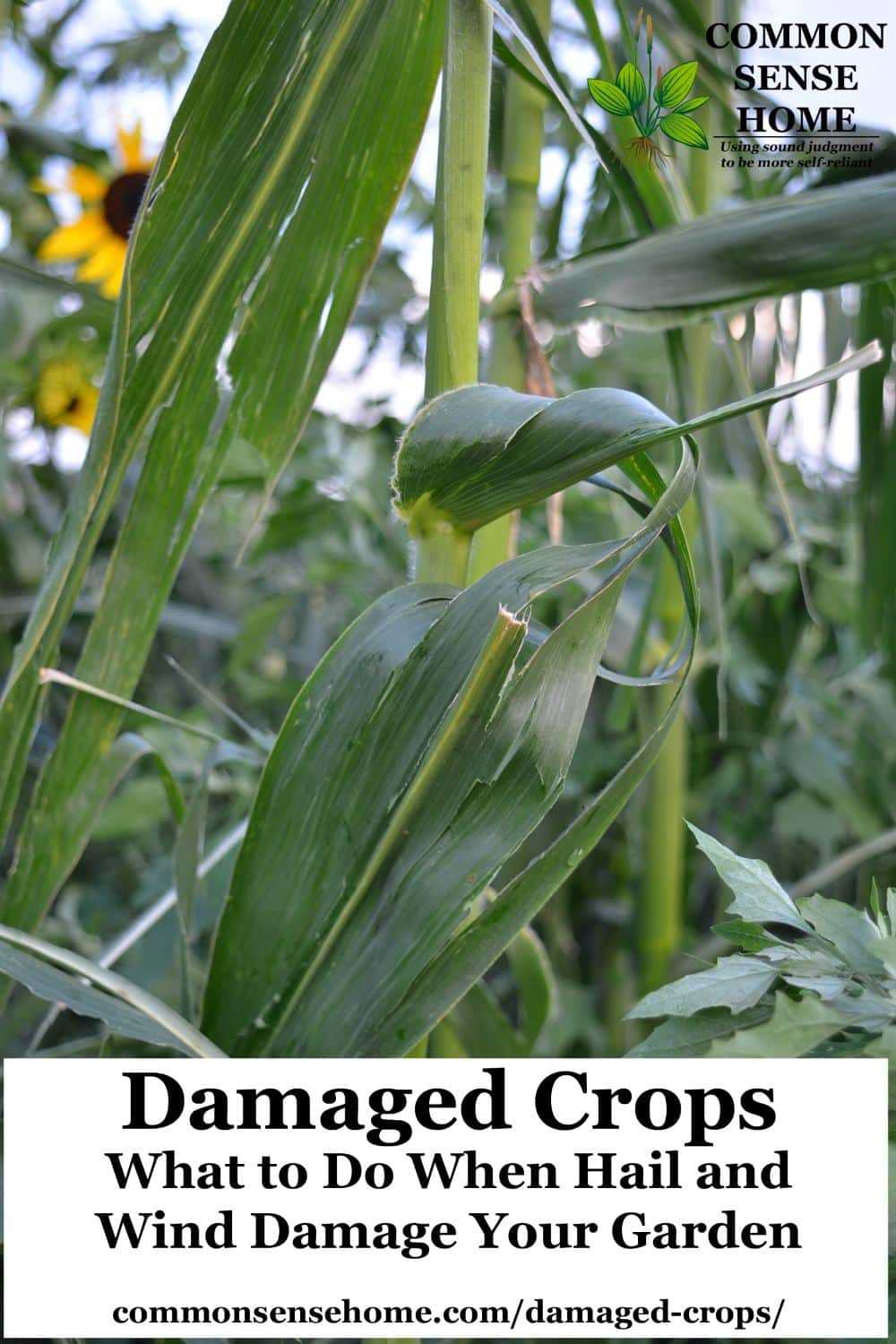
Feed the Leaves
Vining crops like squash and tomatoes should sprout new growth if the plants were healthy before the weather damage. Watch for the new leaves to emerge, and feed them with a foliar feed like kelp extract or fish hydrolsate (such as Drammatic O Fish Fertilizer). Crops like corn are unlikely to put out new leaves (unless the plants are small). Damaged leaves can still photosynthesize, so it’s okay to treat them with foliar fertilizer.
Hold off on Trimming
As mentioned above, damaged leaves can still function, just not as well as they once did. Don’t trim them immediately. Give the plant a chance to grow new leaves and draw nutrients out of the old leaves before trimming.
With damaged herbs, you may be able to trim back the top leaves, which bore the brunt of the weather damage, to reveal less damaged leaves below. See section on damaged flowers below for tips on how to cut back stems.
Play some Plant Music
The correct type of sounds, like morning bird songs, can stimulate plants to open their stomata wider. These tiny leaf openings let them drink in the morning dew- and better absorb foliar feeds.
They’re partial to Vivaldi’s Four Seasons – Spring, which is similar in tone to bird song, and other similar tones.
Play music early in the day (before 10am) to augment the plant’s natural cycle. By midday, the stomata should be mostly closed to protect the plant from the heat of the day.
For more details, see “Music for Plants – What Helps Plants Grow and What Doesn’t“.
Related studies:
- Effect of sound on plant growth
- Effect of Music on Plants – An Overview
- The Effect of Music on Plant Growth and Pests
Would you like to save this?
Damaged Flowers
Flowers that are bruised or missing petals can’t heal. It’s best to dead head to let the plant shift resources to growing new blossoms, or let blossoms drop naturally. Damaged flowers are still safe to use dry or make into salve. They should be harvested within a day after the storm damage, before they start to spoil.
When removing damaged flowers, don’t cut the stem off right below the flower. Instead, follow the stem down to a leaf branch. Cut the stem at a 45 degree angle, about one fourth inch above the leaf joint. This will encourage new growth to sprout from the leaf joint area and below.
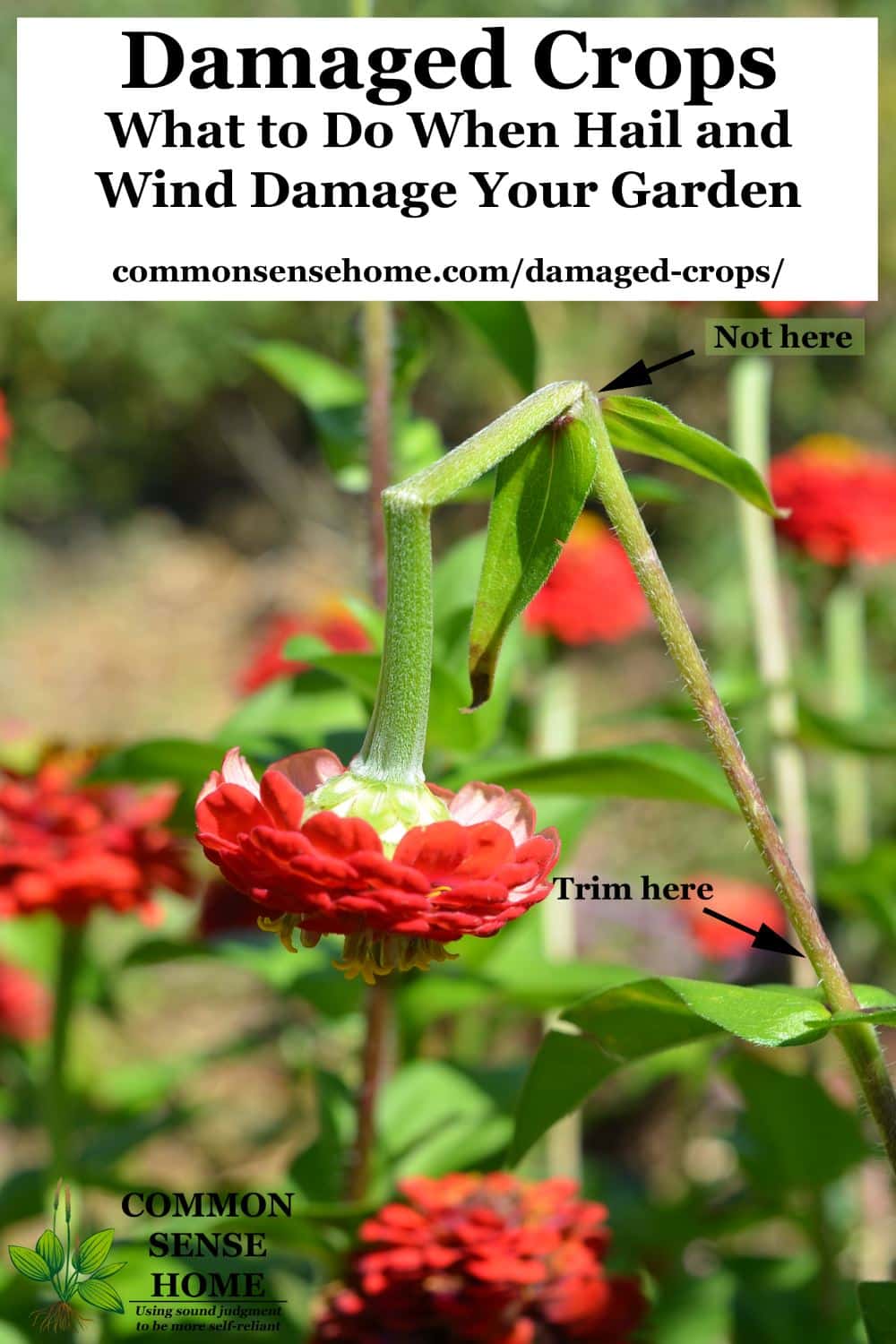
Blossom damage will stall out new fruit set, delaying the harvest.
Damaged Fruit
Damaged fruit is the worst, because it’s unlikely to recover. If a fruit has split from hail damage, it’s a goner. Process immediately if it’s far enough along to be useful. If not, remove and compost. My friend, Tami, lost this beautiful young melon in last week’s storm.
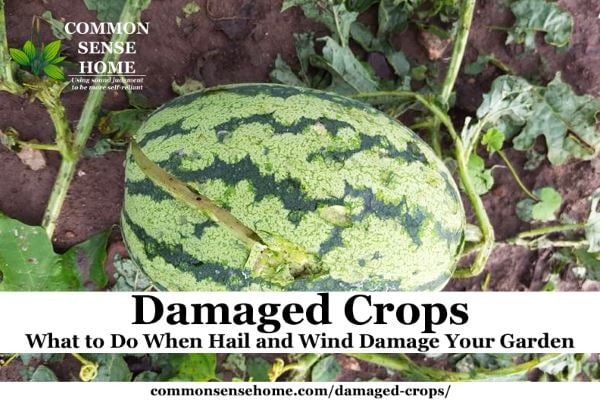
My melons are pitted, and may well spoil before ripening, but there’s not enough time left in our growing season to start new, so I’m leaving them and hoping for the best. If you have enough time in your growing season, it’s best to remove heavily bruised fruit. This allows the plant to start over and put energy into new, undamaged fruit.
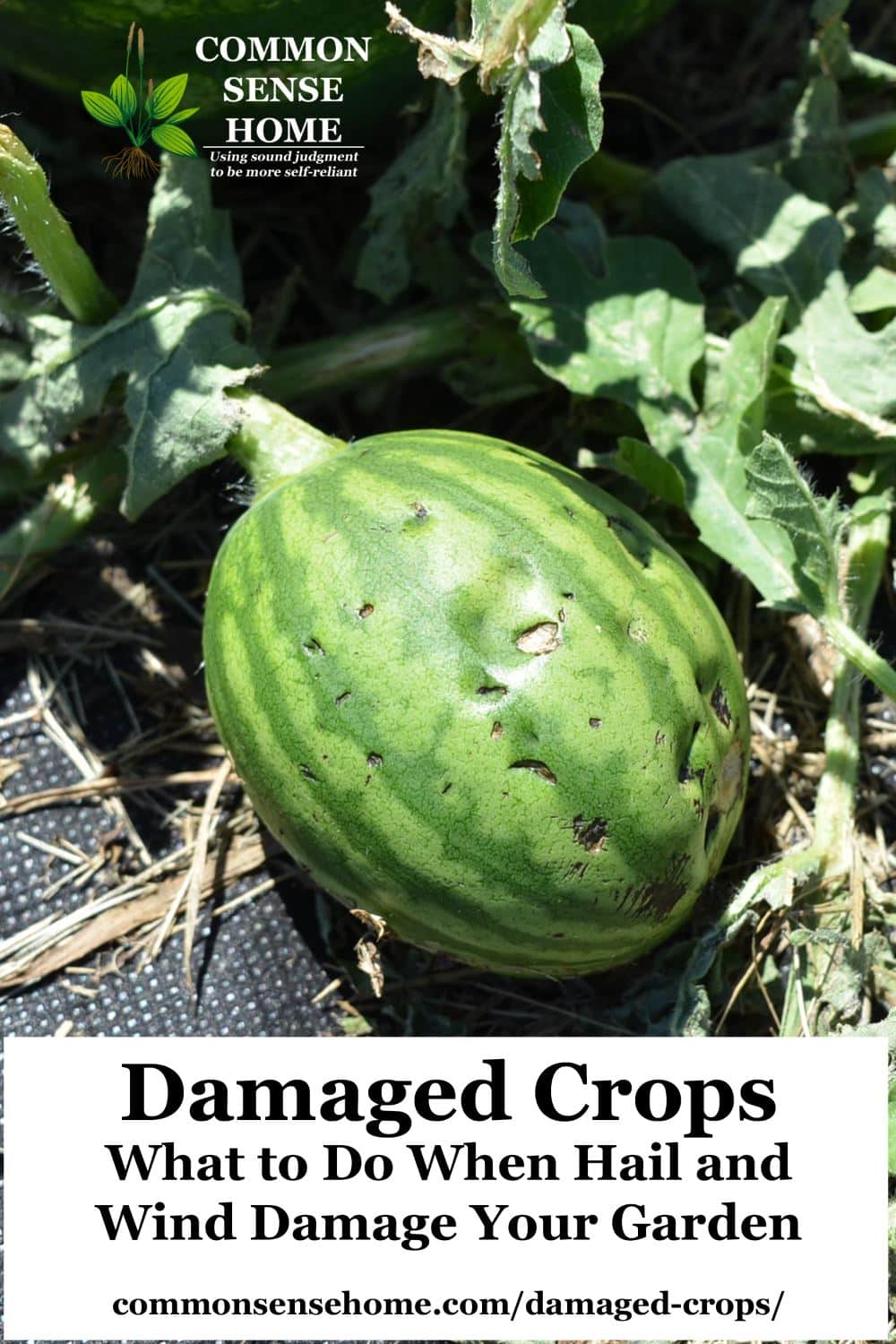
Many tomatoes were knocked from the vines. We’re gathering and processing the fruit that isn’t badly damaged and composting the rest. Fallen fruit will attract slugs and other scavengers, so it’s best to clear it out. A number of tomatoes still on the vine split, so they needed immediate processing. Unripe tomatoes that split are likely to rot before they ripen. Use them green, or compost.
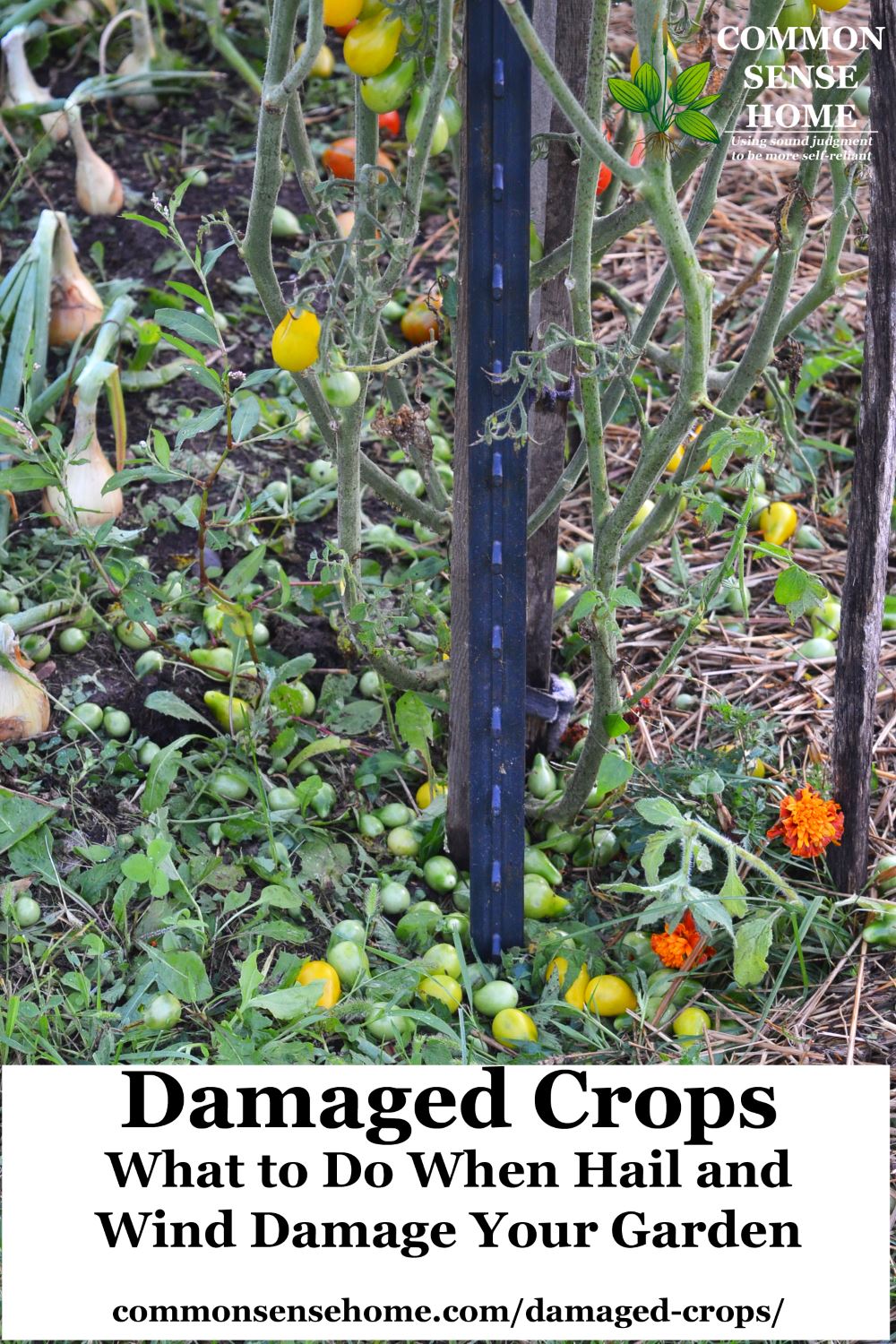
Preventing Hail Damaged Crops
Had I known to expect hail, or been home when it hit, I might have been able to lessen the hail damage. Floating row covers and tarps thrown over a plant area can diffuse the impact enough that the plants will be flatter but not shredded.
I also noticed that our vertical plantings fared better than those on the ground, for the most part. The upper leaves took the brunt of the hail impact, protecting the leaves below. The trellises would have made a natural anchor for tarps or row covers, too.
For those who live in areas that are prone to hail damage, there are specialized hail protection products, including:
Floating row covers – Non-woven polypropylene fabric covers protect seeds, plants, fruit and vegetables against frost, bird and insect damage. Porous, strong and lightweight, easy to cut to size.
Heavy Duty Anti-Hail Netting – Protects crops from hail and wind damage. Best attached to a hoop frame or other framework mounted above the plants.
Individual Plant Protectors – Pup tents for your plants offer protection from freezing rain, winds, insects, hail and frost.
If plants are flattened by wind damage or hail, gently prop them back up as soon as possible, so they don’t start growing crooked.
It’s Been a Tough Year in the Garden
We lost most of our fruit tree fruit to a late frost. June was non-stop rain, July saw almost no rain. August brought hail and temperature swings. How the season will finish is anyone’s guess. I’m grateful that we still have food in storage from previous years, and that we aren’t completely dependent only on what we can produce ourselves. We’ll still get a harvest, but it’s not what it could be. It’s a humbling reminder that the food on all our tables could easily disappear if crop damage was more widespread. Home food preservation and storage is like insurance for when years like this one hit.
Do you have a garden question or problem, or other tips you’d like to add? Leave a comment and share your thoughts. Post shares are always appreciated, too.
Related articles you may also find helpful:
- 4 Reasons your Tomatoes Aren’t Ripening
- Summer Gardens – Dealing with High Temperatures in the Garden
- Too Much Rain in the Garden – Managing Wet Dirt and Waterlogged Plants
P.S. – This is the hail that stacked up outside the garage door. It looked like snow in August.
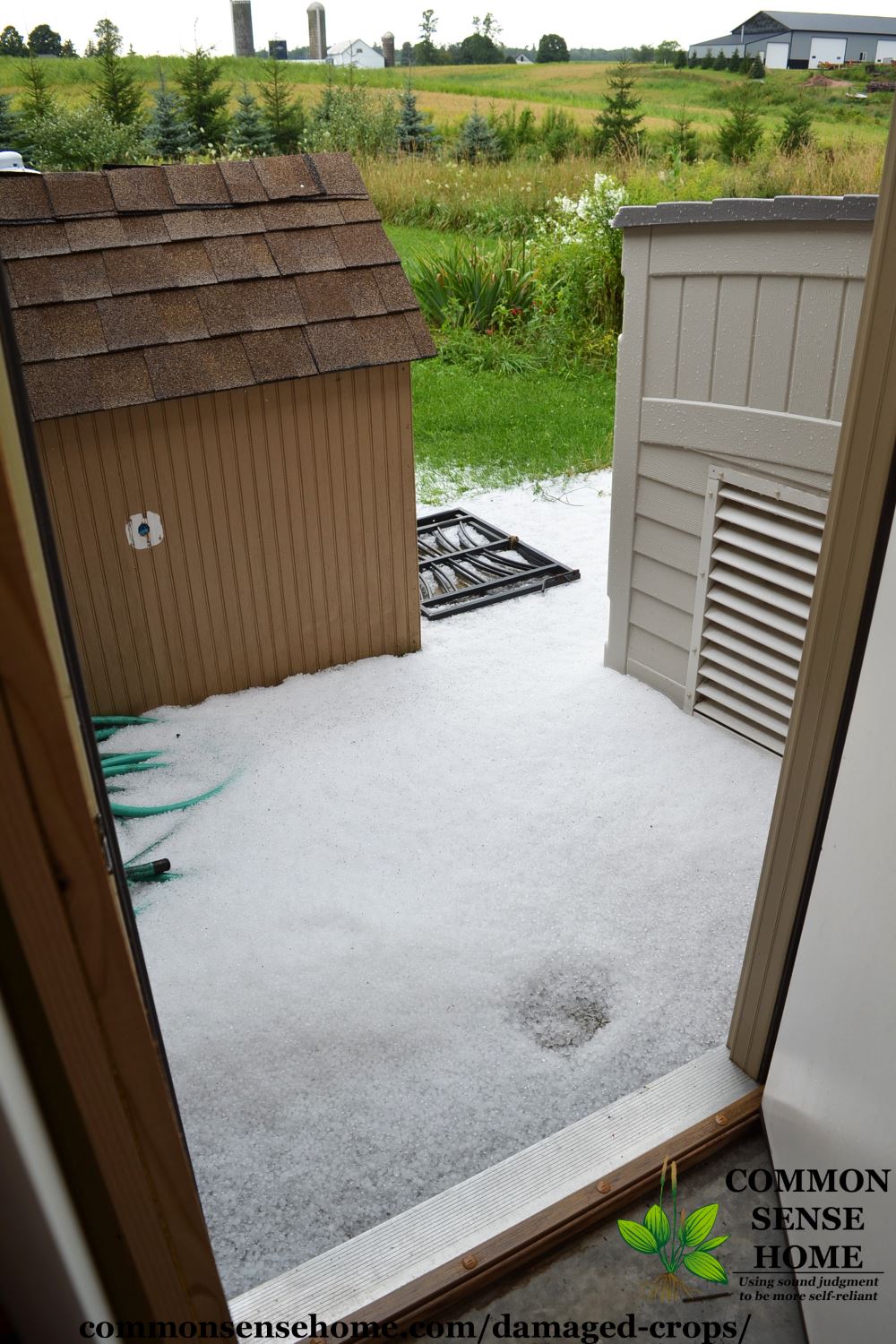

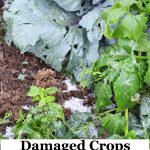
Great article about what to do with damaged plants! Thanks, Laurie!
Thank you, and you’re welcome. I hope no one needs the information, but sometimes we need to make the best of a bad situation.
I knew you would take this lemon of a year and make lemonade. You will definitely be more prepared than before for having experienced it. Thanks for sharing about EM-1.
I don’t know that much of anything could have completely prepared me for this year, but I keep trying. We’re working on improving the soil in the greenhouse, so hopefully next year that will perform even better. We got some bad compost a few years back, and ever since then the wheel has struggled, but hopefully that will be better soon, too.
Wow! Hail in August. I have the opposite problem – high heat and no rain here is Southern CA. The weird weather changes have affected our personal trees and local fruit orchards which haven’t been able to host U-pick on cherry’s for several years and it is starting to affect other crops as well. This Winter/Spring was the first year we had a normal “rainy” season and broke our drought, but we are still getting odd mixes of up and down cool/hot weather that confuses plants and pollinators. If I have learned anything about gardening it is to keep at it…Plants are resilient… I hope you still get watermelons!
It’s been a weird weather year in many parts of the country.
My son hit everything with foliar feed this morning, and we’ve been playing music for the poor things. Hopefully frost will be late this year and there will be time for the plants to recover.
Laurie, when I saw the first post about the hail I was so broken hearted for you. All that damage! When my garden flooded years ago, too late to plant again, I was devastated. It made me appreciate what our fore fathers went through when they didn’t have a grocery store to go to. Hope your plants recover enough to give you a decent harvest. Never knew about the music, fascinating !
Good luck and thank you for sharing your knowledge with us.
Penn Young, North Ridgeville, Ohio
I’ve been lucky compared to some, since this is the worst damage I’ve had in all my years of gardening, and I’ve been at it for many years. It was hard to see all the damage, but it could have been worse. I’m canning tomato soup and dilly green tomatoes to use up the damaged fruit that was fit to salvage.
Oh, Laurie, I am so sorry to hear you had such serious damage! The best we can say about our garden this year is that is is growing modestly, with summer squash just beginning to produce, winter squash still alive but not thriving, cucumber number four beautiful, fat and safely indoors with three more vines’ worth more on the way, third planting of beans bravely starting to climb, peas fruiting for a blessed second time, raspberry patch and all of our other wild berries with just a faint scattering of ripening fruit. We have three pints of dehydrated Jewel strawberries; and the rain hatched an all time war between the Slugs and the Mice on our everbearing strawberry patch leaving us not much of a late first flush and a pretty scant second. We trimmed off and ate the survivors. I still have some Laurie-style fantastic grated and dehydrated summer squash, the last of a jar of 2016 strawberries and one of quart of blanched and dehydrated green beans (cooks up great, as opposed to the non-blanched, which Applachians refer to as “leather britches”!).
We discovered a few years ago that we like lamb’s quarters better than spinach, and have plenty this year to split between dinner and the chickens, with millions of seeds ripening for next year If some seeds sprout while it’s still warm I’ll have enough to dry. Fruit trees are in their third year, and flourished in the rain, so may fruit next year. We are leveling ground for our second try at a cold frame, and have deferred but not forgotten prepping a site for our geodesic zip-tie greenhouse dome in deference to building a winter coop for the chickens this month.
The chickens are working on the plots we will use next year for their grain and greens. We are planning to start a stockpile of feed to get them through the winter and hopefully enough to take them into mid-Spring, and are building a small mountain of coppice/leaf /garden waste compost for winter entertainment. My first North American garden failed to grow in Denver clay. My second grew slowly in the high desert of the Navajo Nation, was cut an inch or so above the ground by a 1 inch deep July hailstorm and got eaten around the fenced edges by stray horses. Hail damage has been a quiet little terror in my mind for every garden since then. I wish I had known about the recovery protocols you just shared, and think I will print this post one out in hard copy and maybe put it under my pillow for every summer that I garden from now on. I’m looking forward to reading the comments and recommendations that are sure to flod in on this post. I’m betting you will harvest a good list of additional strategies within the week. When it hails lemons, sprout broccoli!
Sorry that your gardens have struggled so. It sure can be challenging to get a harvest when Mother Nature doesn’t cooperate. I’m loving our ducklings for slug control, and the cats take out the mice and ground squirrels that try and move into the garden.
I’ve heard of leather britches, but never tried them? How do they compare to regular blanched and dehydrated beans?
In Appalachia, green beans were sewn with thread through the middle and hung to dry a bit like chili ristras. The beans were often boiled with ham hocks. They remain chewy and do not plump up at all. Fond memories of leather britches are more nostalgia, than gastronomy talking IMO .Blanching before dehydrating speeds up the coking time and yields tender sliced green beans. They don’t taste like canned bean or frozen beanss, but they do have a delicate flavor and are far easier to chew and swallow than the britches.. I found that the pre-blanched, dehydrated Romano beans made pretty nice snack food with a little olive oil and sea salt.
I was thinking that they would have to stay tough if they weren’t blanched – but of course that would help them hold up in storage, too.
Meant to say that my funny brain doesn’t mind a tough situation so long as I learn something useful from it. Despite some doozy garden disasters, I am still gardening and enjoying NEARLY every minute of it!
The ducklings are making this gardening year considerably more entertaining, in spite of the bad weather.
I listened to the Dirt Doctor, aka Harold Garrett on Sunday mornings. He has often said not to use fish emulsion because chemicals are used during the emulsion process. Harold recommends fish hydrolsate.
Thanks for catching that. I’ve actually been using Drammatic O Fish Fertilizer for the last two years, which is a hydrolsate, but had used fish emulsion for years because it was the only thing available at the local garden center. I contacted Dramm last year (they are fairly near us), and the rep stopped in with two monster jugs so I got bulk pricing.
So sorry you got the hail damage. We had the heavy rain on Thursday too, and it started hailing. It was only pea sized though and didn’t do any damage. Some of the corn fields around here got bad hail damage a few weeks back and they grew back nicely. Hope you can salvage most of it.
Thanks for your words of encouragement. Some things, like the pole beans, look pretty good. Our pickling cucumbers are decimated, but I did have a few slicing cucumber plants in the greenhouse that survived. We’ll give everything some TLC and see what happens.